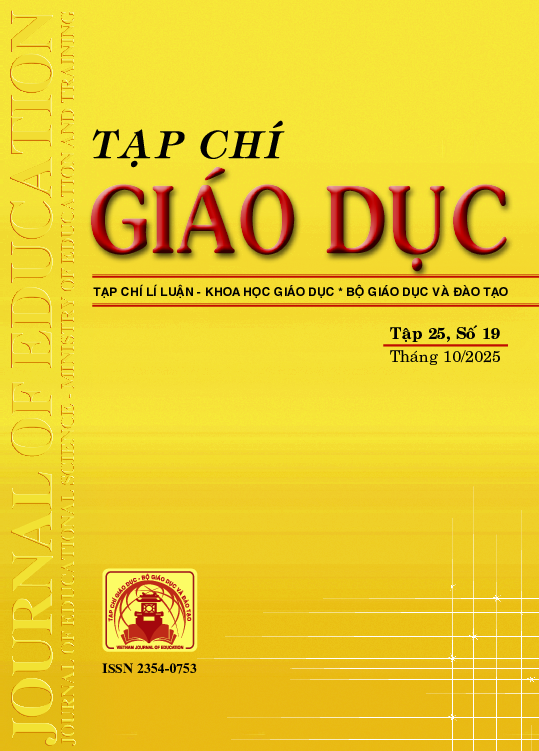Xu hướng nghiên cứu về lí thuyết Realistic Mathematics Education (RME): góc nhìn dựa trên phân tích trắc lượng thư mục
Tóm tắt
Realistic Mathematics Education (RME) is a mathematical education theory from the Netherlands that has been extensively researched and garnered significant attention from mathematics educators globally. Through a bibliometric analysis of 331 research articles related to RME theory sourced from Scopus data, this study examines the development stages of RME from 1972 to 2024. The majority of the research publications originate from three countries: Indonesia, the Netherlands, and the United States, reflecting the widespread interest and application of RME in these regions. The analysis also identifies key research themes, which predominantly revolve around three main areas: (1) problem-solving, (2) research design and (3) the fundamental principles of RME. The findings of this study not only provide insights into current trends and strengths in RME research but also highlight potential avenues for future exploration, particularly in the development and enhancement of creative teaching methodologies grounded in RME theory.
Tài liệu tham khảo
Afriansyah, E. A., & Arwadi, F. (2021). Learning Trajectory of Quadrilateral Applying Realistic Mathematics Education: Origami-Based Tasks. Mathematics Teaching Research Journal, 13(4), 42-78.
Bayrak, A., & Aslanci, S. (2022). Realistic Mathematics Education: A Bibliometric Analysis. Shanlax International Journal of Education, 10(4), 52-62. https://doi.org/10.34293/education.v10i4.5174
Chasanah, C., Riyadi, & Usodo, B. (2020). The effectiveness of learning models on written mathematical communication skills viewed from students’ cognitive styles. European Journal of Educational Research, 9(3), 979-994. https://doi.org/10.12973/EU-JER.9.3.979
Cooper, B. (1998). Using Bernstein and Bourdieu to understand children’s difficulties with “realistic” mathematics testing: An exploratory study. International Journal of Qualitative Studies in Education, 11(4), 511-532. https://doi.org/10.1080/095183998236421
Dang, H. T. T., Thi Bui, D., & Nhan, T. T. (2023). Enhancing creativity in secondary school mathematics: A quasi-experimental, mixed methods study in Vietnam. Issues in Educational Research, 33(2), 488-509.
Davis, E. K. (2017). A three-tier teaching model for teaching mathematics in context. For the Learning of Mathematics, 37(2), 14-15.
Davison, D. M., & Mitchell, J. E. (2008). How is mathematics education philosophy reflected in the math wars? The Mathematics Enthusiast, 5(1), 143-154. https://doi.org/10.54870/1551-3440.1092
Den Heuvel-Panhuizen, V., & Van Zanten, M. A. (2020). Realistic Mathematics Education: A brief history of a longstanding reform movement. Mediterranean Journal for Research in Mathematics Education, 17, 65-73.
Dieudonné, J. (1961). New Thinking in School Mathematics. Nature, 191(4786), 335-335. https://doi.org/10.1038/191335b0
Fauzan, A., & Arnawa, I. M. (2020). Designing Mathematics Learning Models Based on Realistic Mathematics Education and Literacy. Journal of Physics: Conference Series, 1471(1), 012055. https://doi.org/10.1088/1742-6596/1471/1/012055
Freudenthal, H. (1972). Mathematics as an Educational Task. In Mathematics as an Educational Task. Springer Science & Business Media. https://doi.org/10.1007/978-94-010-2903-2
Gee, E., Fauzan, A., & Atmazaki, A. (2018). Designing learning trajectory for teaching sequence and series using RME approach to improve students’ problem solving abilities. Journal of Physics: Conference Series, 1088(1), 012096. IOP Publishing. https://doi.org/10.1088/1742-6596/1088/1/012096
Gravemeijer, K. (1994). Developing Realistic Mathematics Education. In Faculty of Sciences, Freudenthal Institute.
Hallinger, P., & Kovačević, J. (2019). A Bibliometric Review of Research on Educational Administration: Science Mapping the Literature, 1960 to 2018. Review of Educational Research, 89(3), 335-369. https://doi.org/10.3102/0034654319830380
Herold, J. (1974). Sputnik in American education: A history and reappraisal. McGill Journal of Education, 9(002). https://mje.mcgill.ca/article/view/6971
Heuvel-Panhuizen, M. Van den. (1996). Assessment and Realistic Mathematics Education. ERIC.
Inam, O., Qureshi, M., Akram, H., Omer, H., & Laraib, Z. (2019). Accelerating Parallel Magnetic Resonance Image Reconstruction on Graphics Processing Units Using CUDA. 2019 IEEE 2nd International Conference on Information and Computer Technologies, 109-113. https://doi.org/10.1109/INFOCT.2019.8710946
May, K. O. (1972). Teachers Should Know About Mathematics. International Journal of Mathematical Education in Science and Technology, 3(2), 157-158. https://doi.org/10.1080/0020739700030207
Muttaqin, H., & Putri, R. I. I. (2017). Design Research on Ratio and Proportion Learning by Using Ratio Table and Graph with Oku Timur Context at the 7th Grade. Journal on Mathematics Education, 8(2), 211-222.
Phan, T. T., Duong, H. T., Do, T. T., Trinh, T. P. T., Trinh, T. H., Do, B. C., Tran, T., & Nguyen, T. T. (2022). A Bibliometric Review on Realistic Mathematics Education in Scopus Database between 1972-2019. European Journal of Educational Research, 11(2), 1133-1149. https://doi.org/10.12973/eu-jer.11.2.1133
Syutaridho, S., Ramury, F., & Nurhijah, N. (2023). The influence of Indonesia’s Realistic Mathematics Education approach on students’ creative thinking ability. Jurnal Ilmiah Ilmu Terapan Universitas Jambi, 7(2), 99-111.
Thalhah, S. Z., Angriani, A. D., Nur, F., & Kusumayanti, A. (2021). Development of Instrument Test Computational Thinking Skills IJHS/JHS Based RME Approach. Mathematics Teaching Research Journal, 13(4), 202-220.
Tong, D. H., Nguyen, T.-T., Uyen, B. P., & Ngan, L. K. (2023). Using m-learning in teacher education: A systematic review of demographic details, research methodologies, pre-service teacher outcomes, and advantages and challenges. Contemporary Educational Technology, 15(4), ep482. https://doi.org/10.30935/cedtech/13818
Treffers, A. (2012). Three dimensions: A model of goal and theory description in mathematics instruction-The Wiskobas Project (Vol. 3). Springer Science & Business Media.
Van den Heuvel-Panhuizen, M. (2003). The didactical use of models in Realistic Mathematics Education: An example from a longitudinal trajectory on percentage. Educational Studies in Mathematics, 54(1), 9-35. https://doi.org/10.1023/B:EDUC.0000005212.03219.dc
Van den Heuvel-Panhuizen, M. (2020). International reflections on the Netherlands didactics of mathematics. Springer Nature. https://doi.org/10.1007/978-3-030-20223-1
Zaranis, N., & Synodi, E. (2017). A comparative study on the effectiveness of the computer assisted method and the interactionist approach to teaching geometry shapes to young children. Education and Information Technologies, 22, 1377-1393.
Zulkardi, Z., Putri, R. I. I., & Wijaya, A. (2020). Two Decades of Realistic Mathematics Education in Indonesia (pp. 325-340). https://doi.org/10.1007/978-3-030-20223-1_18
Tải xuống
Đã Xuất bản
Cách trích dẫn
Số
Chuyên mục
Giấy phép

Tác phẩm này được cấp phép theo Ghi nhận tác giả của Creative Commons Giấy phép quốc tế 4.0 .












